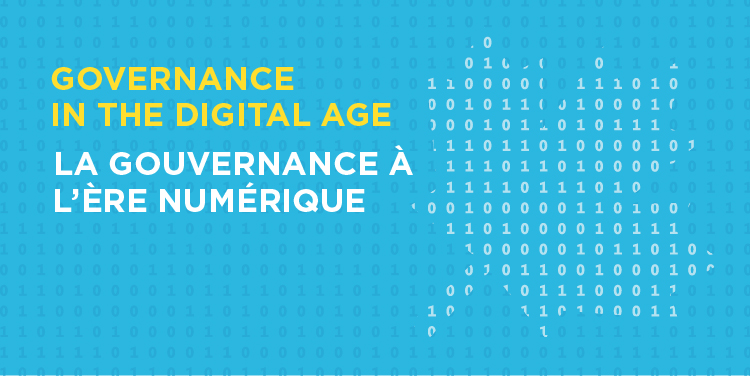
Governance in the Digital Age
There’s a persistent orthodoxy about how the world is changing and how government should change with it. We hear words like agile, connected, responsive, user-centric, open and innovative.
And we hear that the world is increasingly complex, or the rate of technological progress is too fast for governments to keep up, so government must change. Governments have been hearing this recommendation for decades and changing only at the surface—rarely at their foundations. This could be because we are misdiagnosing the problem, coming up with the wrong solutions or failing to implement solutions correctly.
In 2016–2017, the Public Policy Forum dedicated the Prime Ministers of Canada Fellowship to the idea of “governance in the digital age.” The goal was to explore and explain how the world is changing and how governments are responding.
The report you are reading is intended as a resource to practitioners and a conversation starter for those who are thinking about the pressures of change on our governance systems. It is the result of a year of research, surveys and interviews with almost 300 government practitioners and stakeholders in Canada and across the world.
This report discusses the concepts of open government, digital government, public sector innovation and how governments are trying to manage rapidly changing technological and societal trends. It looks for common patterns in behaviour and practice, and how those patterns have played out in various contexts.
This report is not about, for example, whether governments need to engage more with citizens and across sectors. Rather, the starting point is this: If more engagement were a goal, how would it succeed and how would the structures of government create challenges?
In the course of my research, I heard two competing analyses: one early and common hypothesis was that the structures and designs of government aren’t set up for digital-era governance. The other view was that, on close scrutiny, we see that our public governance is reasonably effective; for instance, Canada’s civil service has been ranked as the most effective in the world.[1] And we can find some stellar success stories for digital transformation and open government.
After a year of interviews, the hypothesis that government is not set up for digital-era governance appears to hold up. Success stories for digital governance, while they exist, are not the norm. Initiatives to transform to digital governance across jurisdictions rely on a web of workarounds, fast tracks, exemptions and executive air cover. Stories of progress in digital transformation followed by backslide are common; the departure of a single key official is in some cases enough to derail a whole program.
This leads to another common storyline: Often, responsible executives are unaware of implementation challenges and how frustrating the employee or citizen experience could be. Executives have line of sight to the programs and services that benefit from their oversight and intervention; the ones that are struggling because they can’t get attention are necessarily hidden from view. The tip of the iceberg looks very different from the rest of it.
Effective governance depends on the work of responsible officials who have an honest and accurate understanding of both progress and challenges.
The digital era is shining a light on how important that understanding is. The more data we have about the world, the more we recognize how complex it is. Governments have to solve problems with an approach that is more holistic, more contextualized to people’s needs and that reflects more voices. Meanwhile, technology is becoming increasingly specialized, mixes in unpredictable ways, and advances at scale across the globe rapidly. It’s becoming more challenging for governments to keep up with the state of the market, whether they are trying to take advantage of technology or govern it.
The choices in front of governments
The defining challenge of the digital era is complexity.
Governments are making progress: They are moving from a model of planning and evaluating to sensing and responding, and this trend is a common thread across many modernization initiatives, including:
- digital government, which focuses on user research, prototyping, testing and iteration
- open government, which creates opportunities for public review of data and information, and engagement and co-creation to bring context and lived experience into public decisions
- public sector innovation, which expands the sources of problem definitions and solutions, and experiments with policies and programs
The features of the digital world are mirrored in the stated goals of government transformation efforts: governments know that they must be more open so more insight can be included in public decisions, they must be more contextual for user’s needs and behaviours, and they must be more horizontal.
Open, contextual and horizontal. These are the features of the changing environment and, likewise, the features of the initiatives with which government is responding. They are also, however, the features of the persistent challenges governments are facing in implementation. Government needs to go precisely where it’s hard to get.
Governments are machines designed to make tradeoffs and hard decisions—to aggregate citizens’ views into a democratically legitimate, if imperfect, concept of the public interest. In 1959, one public administration scholar claimed that large-scale, long-term experiments were the only practical way to govern; the world was too complex, with too many variables, to try to understand and influence.[2]
Government’s lack of time and capacity to manage these variables—and the cost of research and coordination—offsets the benefits of better policy. But the standards are set outside government by the leaders and experts in a given field. In a data-rich world with decentralized policy expertise and transparency mechanisms, government can never be good enough. Now we have the data to know who is losing in a one-size-fits-all, large-scale policy experiment—and we rightfully deem it unfair.
So what, then, can governments do?
If the problem is to become more contextual to individuals’ needs, governments should delegate down and push decision making to the front lines. However, if the problem is horizontality and coordination between organizations, governments should make sure that information and decisions flow through central nodes.
If the problem is to understand the changing technological and societal context, governments should become facilitators and conveners. However, if the challenge is to exercise stewardship of the public good, governments need to bolster policy capacity.
Put differently: there are no solutions, only choices. But there are proven and promising approaches for reliably making good choices over time in new and changing contexts. In his 1999 book on renewing governance for the information age, Steven Rosell called this “governing by learning.”[3] In 2007, the Crossing Boundaries working group declared that “governments must stop trying to plan for things they cannot know and focus instead on learning to manage change.”[4]
To support that goal, government must invest in a stack of complementary strategies.
Strategies for Government
Build Process Skills
Organizational learning doesn’t happen on its own. In a world with no playbooks, maps or right answers, it is crucial to build skillsets for leading groups of people to make insights and decisions. Process skills are embodied by the following people:
- user researchers and user experience designers (and testers), who are crucial to digital government initiatives
- foresight specialists who can help organizations explore plausible futures and imagine different scenarios—and what the implications would be
- citizen-engagement practitioners who can bring insight and expertise into government, and design public involvement
- learning organization and facilitation experts who can guide teams to define missions and then run post-mortems so they get an accurate understanding of why outcomes happened (often appears as “design thinking” these days)
- experimentation experts who can design and evaluate trials, quasi-experiments, before-and-after analyses, and other evaluation and feedback loops
Process skills help people map systems, understand complexity and collaboratively imagine and pursue future states based on a common mental model.
Organizations have always struggled to deploy these skills effectively. Almost every team needs them sometimes, but almost no teams need them full time. Governments recognize that they need more of these people in the ranks, but there’s no logic model to follow through on that intention. Leaving the decision to time- and resource-strapped teams around government has never worked for these skillsets.
The answer is to decide once, and to make the investment at the point of decision. If the assessment is that government needs more designers, user researchers or engagement practitioners, they must build that capacity and make it available across organizations.
Take Specialist Expertise More Seriously
A common theme from interviews was that government can’t throw generalists at problems in specialized fields and expect solid outcomes.
Optimists (typically profit-motivated) tend to drive the discourse about technological change; those who believe in the value of an emerging technology are those who will invest, develop and experiment. Academics and public sector voices follow years later, only once the technology starts generating societal or economic impacts.
Attending a one-day conference on artificial intelligence doesn’t scratch the surface for the understanding required to consider impacts on governance. Multiple interviewees lamented that they and their teams didn’t have the expertise they needed to make confident interventions on major public policy issues that hinged on technology.
Some jurisdictions show a promising pattern, most often under the digital government banner. Incentives are being use to bring top talent into government on tours of duty. In addition, the go-to people in government for specialized policy are invariably embedded in their subject communities via conferences, NGOs and constant learning. Here’s the governance problem: no one is telling specialists to do this, and it’s often on their own dime and time. That makes for an unreliable system.
Governments need to take specialized expertise far more seriously, including knowing what expertise is needed in the first place. For rapidly changing fields, this means that learning and community engagement will have to become a core part of people’s jobs and day-to-day time—not an occasional refresher.
Maintain a Public-Good Ethos
The importance of emphasizing public good principles has never been greater. A common theme from interviews and recent research is that the digital era changes the working context for public officials, putting tension on some fundamental principles of public service. The challenge will be maintaining an emphasis on what we could call the “public service ethos.”
In a slow-moving world, principles about public governance and the roles of public servants could be embedded in policies and processes. But in a dynamic, fast-moving world like ours, officials are left to constantly apply principles to new contexts. This means they must understand both the principles and the contexts at a deep level.
A common theme from interviews was the need to leverage new possibilities and approaches: crowdsourcing, digital engagement, social media, artificial intelligence, challenge prizes, platform models and so on. An equally common theme was the disconnect between people who understand such approaches and people with a deep understanding of the principles behind government work.
Public servants are increasingly public figures, working in the open. The model of career public servants is shifting towards the idea of a porous public sector where expertise moves in and out of government. Some observers call for government policy analysts to move from being policy shapers to being facilitators, collecting and synthesizing ideas from the open public marketplace of input.
The discourse about technology, communications and even open data has often focused on possibilities, excitement and benefits—and fears and costs. Government’s core role has never been more important; it must consider trade-offs, externalities and the public good, navigate competing interests and find a way forward. That role has to happen at the intersection of subject matter expertise and an understanding of the public good—not just the experts standing in your office, but the collective.
The questions to answer here are: do the people who understand the public good understand how the world is changing? Do the people who understand how the world is changing understand the public good?
The section just above on subject matter expertise begins to answer the first question. For the second, governments have to find ways to emphasize, communicate and reinforce principles for the public sector role in a digital age. Relying on process will fail more and more in a world where context is so important.
Promote Transparency and Openness
A transparent and open government addresses two challenges in particular. First, it supports collaboration beyond organizational lines. To be a node in a larger collaborative network, governments need to be open about the data and information they’re working from, and the rationales for their decisions.
Second, it creates an honest, cross-organization accounting of successes and challenges. The lynchpin problem for digital-era governance is that no one, particularly those most responsible for structural governance decisions, has such a landscape view. The status quo is always less risky than the change, and transparency starts to transfer some risk to the status quo. One of the most common themes throughout interviews was how hard it is for the right people in organizations to gain a complete understanding of people’s day-to-day experiences—their frustrations using websites, the unintended consequences of analog-era policies, service experiences, the external changes that could blindside an organization.
Here’s an example: In given day, thousands of people might use a specific government service online. Testing can show what percentage of those people fail to complete their objective because of bad design. User research can capture how personally frustrating and upsetting that experience is, and what it does to people’s view of government. Exposure hours (time spent watching users interact with a government service) can help governments not only to develop better design, but also build more design-oriented organizations.
The problem is that accountability rears its head when a project fails spectacularly. It doesn’t budge for citizens’ ongoing frustrations—until that frustration is captured, tracked and reported online. What’s needed is a landscape view that includes reports, service dashboards, open data, open analytics, and public goal-setting and review.
Governance in the digital age is more
than a ‘challenge’
Progress in digital governance is inevitable. What’s not inevitable is that we will ever get the exact progress we want, with the pace, scale and impact we want.
Governments are currently struggling with change, and it’s not going to get any easier.
We hear that government transformation—as applied to open government, digital government, public sector innovation and technological disruption—is “challenging”. But that makes it sound like we can realize deep transformation with a little legwork and elbow grease. In reality, the word “challenge” drastically undersells the level of investment and commitment needed.
The existence of “challenging” problems suggests a need for policies, change management and champions. But the problems facing governments require more substantial governance levers at the level of laws and institutions, and genuine discussions about the nexus of accountability, expertise and responsibility.
To do less is to decide to muddle through indefinitely.
[1] Blavatnik School of Government. 2017. International Civil Service Effectiveness Index. University of Oxford.
[2] Lindblom, C.E. 1959. The science of “muddling through”, pp. 79–88. Public Administration Review.
[3] Rosell, S.A. 1999. Renewing Goverance: Governing by Learning in the Information Age. Oxford University Press, Inc.
[4] Crossing Boundaries Canada 2020 Working Group. 2007. Progressive Governance for Canadians: What You Need to Know, p. 21. Public Policy Forum.








